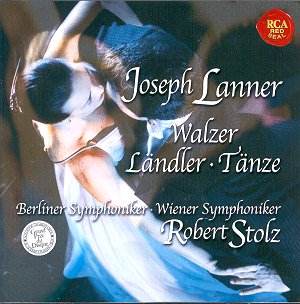Joseph LANNER (1801-43)
Neue Wiener Ländler, op.1, Dornbacher Ländler, op.9,
Trennungswalzer, op.19, Badner Ringln, op.64, Pesther Walzer, op.93, Die
Werber, op.103, Die Kosenden, op.128, Hofballtänze, op.161*, Steyrische
Tänze, op.165*, Die Romantiker, op.167, Abend-Sterne, op.180, Die
Schönbrunner, op.200*
 Berlin Symphony Orchestra,
Vienna Symphony Orchestra*/Robert Stolz
Berlin Symphony Orchestra,
Vienna Symphony Orchestra*/Robert Stolz
Recorded in the Spandauer Festsäle, Berlin and the Grosser
Musikvereins-Saal, Vienna 1966-1971
 BMG Classics RCA Red Seal
74321 84145 2
[78.25]
BMG Classics RCA Red Seal
74321 84145 2
[78.25]
Crotchet
AmazonUK
AmazonUS
Amazon
recommendations

During the 1960s the veteran Robert Stolz (all these recordings were made
between the ages of 86 and 91) set down an extensive programme of Viennese
operetta and dance music for Eurodisc, issued in the UK by World Record Club.
Though RCA tell us nothing of the provenance of the present recordings I
take it that they derive from that series.
At the time it was a penny-in-the-slot critical reaction to look on Stolz
as a series B figure. Composer of numerous operettas which are not remembered
in the way those of Lehár and Kalman are, he recorded in Berlin and
Vienna, but with the Symphony Orchestras not the Philharmonics, and for lesser
recording companies (happy though RCA are to put them out now). Conventional
wisdom had it that he was OK in polkas and marches but could be heavy-handed
with a waltz.
Perhaps because in the intervening years some great names have given us a
number of fairly lugubrious New Year's Day concerts, I must say this CD doesn't
bear out these old prejudices at all. Listen to the really sizzling start
of Die Kosenden; such a capacity to galvanise an orchestra would be
remarkable at any age, let alone 90. And hear how beautifully sprung the
waltz accompaniment is when it starts, and how it never flags. What I will
say is that these are performances for the dancing-floor as much as for the
concert-room. Stolz may make the odd schmaltzy up-beat, he may sometimes
sidle into a new section, but once the dance has started he keeps it going
pretty steadily. These are less inflected performances than we usually hear
today, and there's reason to suppose they may be the more authentic for that.
Far from being a dull dog (and in any case he could be both vital and graceful
as required) Stolz upheld a tradition which we ignore at our peril.
The recordings are rather close but have plenty of brilliance, so this is
the ideal opportunity to hear Lanner as a change from Strauss. Lanner was
the big rival to Strauss Senior, and neither of them was quite on
the level of Johann Strauss the younger. It's delightful stuff, with some
striking instrumental touches, but don't expect to carry the tunes in your
head for days after as you do with the best of Johann Strauss II (except,
perhaps, for the perky little tune from the Steyrische Tänze which
found its way into Stravinsky's Petrushka).
Christopher Howell
http://www.click2classics.co.uk

